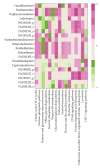Effect of Fermented Red Ginseng Concentrate Intake on Stool Characteristic, Biochemical Parameters, and Gut Microbiota in Elderly Korean Women
- PMID: 35565660
- PMCID: PMC9105854
- DOI: 10.3390/nu14091693
Effect of Fermented Red Ginseng Concentrate Intake on Stool Characteristic, Biochemical Parameters, and Gut Microbiota in Elderly Korean Women
Abstract
Fermented red ginseng (FRG) has been used as a general stimulant and herbal medicine for health promotion in Asia for thousands of years. Few studies have investigated the effects of FRG containing prebiotics on the gut microbiota. Here, 29 Korean women aged ≥ 50 years were administered FRG for three weeks to determine its effect on stool characteristics, biochemical parameters, and gut microbiome. Gut microbial DNA was subjected to 16S rRNA V3-V4 region sequencing to assess microbial distribution in different stages. Additionally, the stool consistency, frequency of bowel movements, and biochemical parameters of blood were evaluated. We found that FRG intake improved stool consistency and increased the frequency of bowel movements compared to before intake. Biochemical parameters such as glucose, triglyceride, cholesterol, low-density lipoprotein cholesterol, creatinine, alkaline phosphatase, and lactate dehydrogenase decreased and high-density lipoprotein cholesterol increased with FRG intake. Gut microbiome analysis revealed 20 specific bacteria after three weeks of FRG intake. Additionally, 16 pathways correlated with the 20 specific bacteria were enhanced after red ginseng intake. In conclusion, FRG promoted health in elderly women by lowering blood glucose levels and improving bowel movement frequency. The increase in bacteria observed with FRG ingestion supports these findings.
Keywords: bowel movements; elderly individual; fermented red ginseng concentrate; glucose; gut microbiota.
Conflict of interest statement
The authors declare no conflict of interest.
Figures






Similar articles
-
Bifidobacteria-Fermented Red Ginseng and Its Constituents Ginsenoside Rd and Protopanaxatriol Alleviate Anxiety/Depression in Mice by the Amelioration of Gut Dysbiosis.Nutrients. 2020 Mar 26;12(4):901. doi: 10.3390/nu12040901. Nutrients. 2020. PMID: 32224881 Free PMC article.
-
Insulin sensitivity improvement of fermented Korean Red Ginseng (Panax ginseng) mediated by insulin resistance hallmarks in old-aged ob/ob mice.J Ginseng Res. 2015 Oct;39(4):331-7. doi: 10.1016/j.jgr.2015.03.005. Epub 2015 Mar 23. J Ginseng Res. 2015. PMID: 26869825 Free PMC article.
-
Gut Microbiome Prolongs an Inhibitory Effect of Korean Red Ginseng on High-Fat-Diet-Induced Mouse Obesity.Nutrients. 2021 Mar 12;13(3):926. doi: 10.3390/nu13030926. Nutrients. 2021. PMID: 33809267 Free PMC article.
-
Association between Altered Blood Parameters and Gut Microbiota after Synbiotic Intake in Healthy, Elderly Korean Women.Nutrients. 2020 Oct 12;12(10):3112. doi: 10.3390/nu12103112. Nutrients. 2020. PMID: 33053824 Free PMC article.
-
Gut Microbiota: Therapeutic Targets of Ginseng Against Multiple Disorders and Ginsenoside Transformation.Front Cell Infect Microbiol. 2022 Apr 25;12:853981. doi: 10.3389/fcimb.2022.853981. eCollection 2022. Front Cell Infect Microbiol. 2022. PMID: 35548468 Free PMC article. Review.
Cited by
-
Ginseng as a therapeutic target to alleviate gut and brain diseases via microbiome regulation.J Ginseng Res. 2025 Jan;49(1):12-21. doi: 10.1016/j.jgr.2024.04.005. Epub 2024 Apr 27. J Ginseng Res. 2025. PMID: 39872288 Free PMC article. Review.
-
Evaluating the Anti-Osteoporotic Potential of Mediterranean Medicinal Plants: A Review of Current Evidence.Pharmaceuticals (Basel). 2024 Oct 8;17(10):1341. doi: 10.3390/ph17101341. Pharmaceuticals (Basel). 2024. PMID: 39458982 Free PMC article. Review.
-
Current landscape of fecal microbiota transplantation in treating depression.Front Immunol. 2024 Jun 25;15:1416961. doi: 10.3389/fimmu.2024.1416961. eCollection 2024. Front Immunol. 2024. PMID: 38983862 Free PMC article. Review.
-
Role of traditional Chinese medicine in age-related macular degeneration: exploring the gut microbiota's influence.Front Pharmacol. 2024 Jan 25;15:1356324. doi: 10.3389/fphar.2024.1356324. eCollection 2024. Front Pharmacol. 2024. PMID: 38333011 Free PMC article. Review.
-
Application of probiotic bacteria in ginsenoside bioconversion and enhancing its health-promoting benefits: a review.Food Sci Biotechnol. 2024 Nov 12;34(8):1631-1659. doi: 10.1007/s10068-024-01734-6. eCollection 2025 Apr. Food Sci Biotechnol. 2024. PMID: 40160953 Review.
References
-
- Seong E., Bose S., Han S.-Y., Song E.-J., Lee M., Nam Y.-D., Kim H. Positive influence of gut microbiota on the effects of Korean red ginseng in metabolic syndrome: A randomized, double-blind, placebo-controlled clinical trial. EPMA J. 2021;12:177–197. doi: 10.1007/s13167-021-00243-4. - DOI - PMC - PubMed
MeSH terms
Substances
Grants and funding
LinkOut - more resources
Full Text Sources

